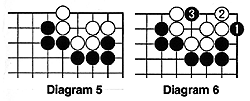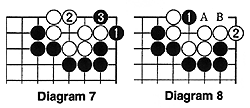Legends on origin of go (1)
In an essay titled "The Earth, the Dead and the Darkness," published in Go World (Summer 1994 issue), Peter Shotwell presents some interesting ideas on the legends swirling around the origins of go in China. I will summarize them in two columns. The second installment will appear next week.The most famous legend tells of King Yao (ca. 2100 B.C.) inventing go to sharpen the mind of his idiot son Danju. As would befit an ancient king, Yao had many sons as well as many wives, but it seems that Danju was one of his favorites, being the son of his number-one wife. In reality, Danju was probably not exactly an "idiot." The meaning of the character that described him is more accurately translated as "quarrelsome" or "disorderly." Perhaps quarreled with his half brothers, who, in palace intrigues, were all plotting to inherit their father's throne. Perhaps Yao's way of giving Danju the advantage over his other sons was to teach him go. Does this story really have a connection with the creation of go?
The Confucians of the Han dynasty tell of Kung Kung, a minister Yao hired to control the floods of the Yellow River. Kung Kung's method failed, so he was driven out of the kingdom. What is interesting about this story is that etymological analysis shows that "Yao" is derived from "mountain," and "Kung Kung" from "quarrelsome" or "unruly." Moreover, this last adjective was always used to describe the raging floodwaters of the Yellow River. The Confucians, it seems, had used a myth in which Kung Kung, a river god, fought the mountain god Yao, and changed it into a bureaucratic dispute of management problems in a virtuous government.
In another legend, it was Yu the Great, an appointee of King Yao, who finally brought the Yellow River floods under control. Attempts to control the flooding by Kung Kung and others failed because of he methods used: the river was dammed. But the dams broke under the pressure of the surging water, causing even more widespread flooding. Yu's method was to siphon off the force of the water by digging many irrigation ditches and letting the floodwaters disperse over the landscape.
It is natural to think of a go board as a network of irrigation ditches. If the lines represent these ditches, placing a stone on them would "dam" the water. By placing more and more stones (dams) on the lines (ditches) the more land--the spaces enclosed by the lines (ditches)--would come under control.
After controlling the floodwaters of the Yellow River, Yu divided China into nine great sectors bordered by rivers, patterned after a 3x3 magic square. With the water now under control, it could be viewed as "ch'i," energy flowing through the countryside, much like the Chinese "science" of geomancy, called feng shui," which holds that there are living, active forces surging through the land and in the shapes and colors of all things around us. Looked at in this way, the go board could be thought of Yu's symbolic map of China. In next week's column, I will expand on this relationship between go and geomancy.
Basics of life and death
During a go game, groups of stones are often isolated. Killing these groups or finding a way for them to stay alive is an essential skill for a strong player. This skill is so important that youngsters aspiring to become professional go players are required to spend many hours each day solving life-and-death problems. In the next few installments, I will introduce some basic techniques that will illustrate the minimum requirements for a group to live.
For a group to live, it must have sufficient space to make two eyes. For example, if it is Black's move in Diagram 1, the white group of seven white stones does not have enough space to live. Black will play 1 and 3 in Diagram 2. If White defends with 2 and 4, Black will make a placement at 5 and the white group cannot make two eyes, so it is dead. That is, at the end of the game it will be taken off the board.

In Diagram 3, the white group on the second line consists of eight stones. This group has enough space to live, even if it is Black's move. If Black plays 1 and 3 in Diagram 4, White has enough room to make two eyes after he plays 2 and 4. If Black makes a placement at 5, White plays 6, and he has the necessary two eyes to live.
The moves Black 1 and 3 in Diagram 2 are called "hane." A hane followed by a placement is the most useful combination for killing groups. Diagram 5 shows another position in which this combination can be used.

Black first hanes with 1 in Diagram 6. If White plays 2, Black makes a placement at 3 and the white stones can not make two eyes. If White answers Black 1 by taking the vital point of 2 in Diagram 7, Black will play another hane at 3; White now has only one eye--the point below 2.
Note that the order of moves here is important. If Black first makes a placement at 1 in Diagram 8, White will play 2. He now has enough space to make two eyes. If Black plays A next, White will play at B to get his second eye.

There are positions where a placement must precede a hane. Diagram 9 is an example. Black first makes a placement at 1 in Diagram 10 to destroy the eye shape of White's position. White must play 2 to prevent Black from linking up his stone at 1 to the ones below. Black next hanes at 3. If White plays A, Black B prevents White from getting two eyes. If White plays at B instead, Black A also prevents White from getting two eyes. If Black hanes at 3 first, White can take the vital point at 1 and make two eyes.

Below are two problems that can be solved by using the hane-placement combination. In the first problem a preliminary move is needed before applying this combination. Black to play in both problems.

